Click on images to enlarge
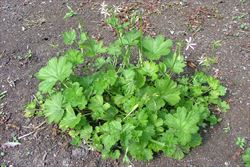
habit (Photo: Sheldon Navie)
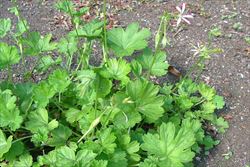
habit (Photo: Sheldon Navie)
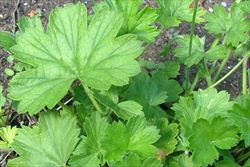
leaves (Photo: Sheldon Navie)
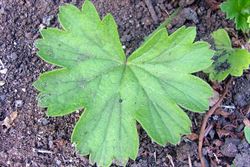
close-up of leaf (Photo: Sheldon Navie)
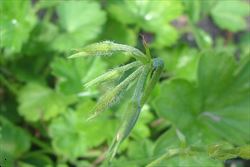
flower buds (Photo: Sheldon Navie)
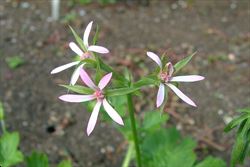
close-up of flowers (Photo: Sheldon Navie)

young seedlings (Photo: Sheldon Navie)

seedling (Photo: Sheldon Navie)
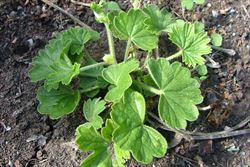
young plant (Photo: Sheldon Navie)
Scientific Name
Pelargonium alchemilloides (L.) L'Hér.
Synonyms
Geranium alchemilloides L.
Family
Geraniaceae
Common Names
garden geranium, lady's mantle-leaf pelargonium
Origin
Native to eastern and southern Africa (i.e. Djibouti, Ethiopia, Somalia, Kenya, Uganda, Tanzania, Mozambique, Zimbabwe, Lesotho and South Africa) and the Arabian Peninsula (i.e. Yemen).
Cultivation
Occasionally cultivated as a garden ornamental in Australia.
Naturalised Distribution
Locally naturalised in the coastal districts of south-western Western Australia.
Habitat
A potential weed of coastal environs, grasslands, shrublands and woodlands in the temperate regions of Australia.
Habit
A low-growing (i.e. decumbent), long-lived (i.e. perennial), herbaceous plant usually about 20 cm tall. Its roots are tuberous, while its aboveground stems may be shorter-lived.
Distinguishing Features
- a low-growing herbaceous plant usually about 20 cm tall, with stems growing up to 80 cm long.
- its roots are tuberous and long-lived, while its above-ground stems may be shorter-lived.
- its irregularly-shaped leaves (2-11 cm across) are moderately to deeply lobed and have toothed margins.
- these leaves (i.e. hispid or pubescent) are somewhat hairy and sometimes have purplish or brownish markings.
- its white or pale pink flowers are borne in loose clusters and radiate from the same point at the tops of a long stalk (i.e. the flowers are arranged in an umbel).
Stems and Leaves
The slender stems are slightly branched and often straggling in nature, growing up to 80 cm long. They are greenish in colour, rounded in shape, and covered with hairs (i.e. pubescent).
The leaves (2-11 cm across) are irregular in shape, but are somewhat round (i.e. orbicular) or broadly egg-shaped in outline (i.e. ovate). They are borne on long stalks (i.e. petioles) and are usually moderately to deeply lobed (i.e. palmatifid), each having about five lobes. These leaves are somewhat hairy (i.e. hispid or pubescent), especially along their veins, and have toothed (i.e. crenate to serrate) margins. They are sometimes also marked with horseshoe-shaped zones of darker variegation, which may be purple, brown or dark red in colour. At the bases of the leaf stalks are small leafy structures (i.e. stipules) 5-17.5 mm long and 2-17 mm wide.
Flowers and Fruit
The flowers are borne in loose clusters, usually containing 5-8 flowers, at the end of a stalk (i.e. peduncle) 6-30 cm long. Individual flowers are borne on shorter stalks (i.e. pedicels) that all radiate from the same point (i.e. the flowers are arranged in an umbel). The flowers have five narrow (i.e. lanceolate) green sepals (7-10 mm long and 1.8-3.5 mm wide) that are somewhat hairy (i.e. pubescent). They also have five white or pale pink petals (occasionally darker pink or red) that are also relatively long and narrow (8-18 mm long and 3-9 mm wide). Each flower also has 5-7 stamens (3.5-6.8 mm long) and an ovary topped with a style that separates into five stigmas. Flowering occurs mainly during spring and summer (i.e. from September to February).
The long and narrow fruit (i.e. schizocarp) turns from green to brown in colour as it matures, and eventually splits into five one-seeded segments (i.e. mericarps) when fully mature. These 'seeds' (i.e. mericarps) are hairy and topped with a long awn.
Reproduction and Dispersal
This species reproduces mainly by seed, but can also reproduce vegetatively via stem segments and its fleshy (i.e. tuberous) roots. Re-growth from the underground root system, which can be up to 6 m long, can occur after long dry periods.
Seeds may be spread by wind, water, animals or in contaminated soil, while seeds and stem segments can be dispersed in dumped garden waste. Broken pieces of the tuberous root system can also be spread by about by graders and other soil-moving activities.
Environmental Impact
Garden geranium (Pelargonium alchemilloides) is regarded as an environmental weed in Western Australia and is also on the Alert List for Environmental Weeds, a list of 28 non-native plants that threaten biodiversity and cause other environmental damage. Although only in the early stages of establishment, it is thought to have the potential to seriously degrade native ecosystems.
Legislation
Not declared or considered noxious by any state government authorities.

